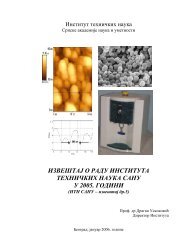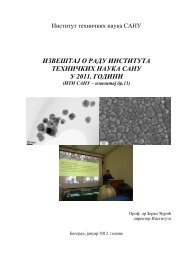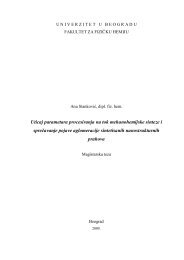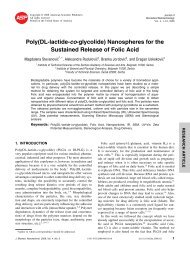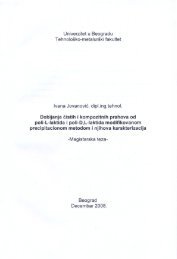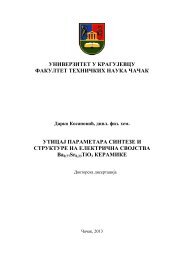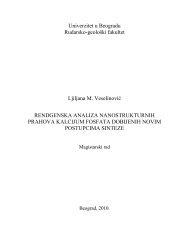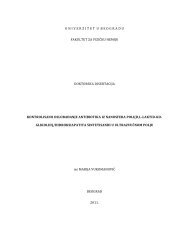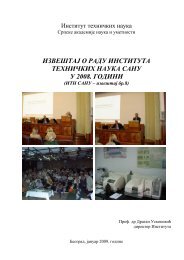Program and the Book of Abstracts (PDF) - Mrs-serbia.org.rs
Program and the Book of Abstracts (PDF) - Mrs-serbia.org.rs
Program and the Book of Abstracts (PDF) - Mrs-serbia.org.rs
Create successful ePaper yourself
Turn your PDF publications into a flip-book with our unique Google optimized e-Paper software.
Tenth Young Researche<strong>rs</strong> Conference – Materials Science <strong>and</strong> Engineering<br />
December 21-23, 2011, Hall 2, SASA, Knez Mihailova 35 & 36, Belgrade, Serbia<br />
IV/2<br />
Spin ordering in quasi-one-dimensional systems<br />
Nataša Lazić, Milan Damnjanović<br />
NanoLab, Faculty <strong>of</strong> Physics, Unive<strong>rs</strong>ity <strong>of</strong> Belgrade, Belgrade, Serbia<br />
Physical properties <strong>of</strong> a particular system essentially depend on all geometrical transformations<br />
which leave that system unchanged. Such transformations form a group. Especially, quasi-onedimensional<br />
systems, including well known nanotubes, can be analized within line groups’ <strong>the</strong>ory.<br />
Some specific properties like magnetic fenomena or spin ordering involve consideration <strong>of</strong> <strong>the</strong> time<br />
reve<strong>rs</strong>al also. In that sense, ionic spin arrangement in a quasi 1D systems must be invariant under<br />
corresponding magnetic (black-<strong>and</strong>-white) line group M(L)= L' + θ l* L', associated to <strong>the</strong> line<br />
group L= L' + l* L'; here L' is a halving subgroup <strong>of</strong> L, l* element <strong>of</strong> <strong>the</strong> remaining part <strong>of</strong> L, <strong>and</strong> θ<br />
is time reve<strong>rs</strong>al. Given spin <strong>of</strong> one ion only, we can find spin arrangements for all o<strong>the</strong>r ions in <strong>the</strong><br />
same chemical species <strong>of</strong> <strong>the</strong> particular system; more precisely, <strong>the</strong> action <strong>of</strong> <strong>the</strong> magnetic line<br />
group M(L) distributes automatically spins along <strong>the</strong> orbit <strong>of</strong> <strong>the</strong> underlying ordinary line group L.<br />
We performed this task for all generic orbits <strong>of</strong> <strong>the</strong> line groups. Extending this concept to <strong>the</strong><br />
multiorbit systems, i.e. with chemically different species we can get insight into <strong>the</strong><br />
(anti)ferromagnetic properties <strong>of</strong> all quasi 1D systems.<br />
IV/3<br />
Carbon nanocoils: structure <strong>and</strong> stability<br />
Zoran P. Popović, Milan Damnjanović, Ivanka Milošević<br />
NanoLab, Faculty <strong>of</strong> Physics, Unive<strong>rs</strong>ity <strong>of</strong> Belgrade, Serbia<br />
Carbon nanocoils (CNC) are experimentally observed by Zhang et al. in 1994, shortly after<br />
being <strong>the</strong>oretically predicted by Ihara et al. Their geometrical structure is usually described by four<br />
paramete<strong>rs</strong>: tubular diameter, pitch, inclination <strong>and</strong> diameter <strong>of</strong> a coil.<br />
Nowadays, CNC syn<strong>the</strong>sized by CVD method, have various helical <strong>and</strong> tubular paramete<strong>rs</strong> <strong>and</strong><br />
regularly coiled structures have periodic incorporation <strong>of</strong> pentagons <strong>and</strong> heptagons into <strong>the</strong> basic<br />
hexagonal carbon network.<br />
Here, we construct model <strong>of</strong> single-wall helically coiled carbon nanotubes by means <strong>of</strong> graph<br />
<strong>the</strong>ory <strong>and</strong> topological coordinates method. After getting three-dimensional coordinates <strong>of</strong> <strong>the</strong><br />
atoms, we proceed with <strong>the</strong> relaxation by successive application <strong>of</strong> <strong>the</strong> following methods: 1)<br />
harmonic approximation; 2) molecular mechanics based on <strong>the</strong> Brenner potential; 3) density<br />
functional tight binding (DFTB).<br />
Finally, by DFTB <strong>and</strong> line group symmetry implemented POLSym code, we calculate total <strong>and</strong><br />
cohesive energy <strong>of</strong> <strong>the</strong> obtained fully relaxed structures <strong>of</strong> CNCs.<br />
16





